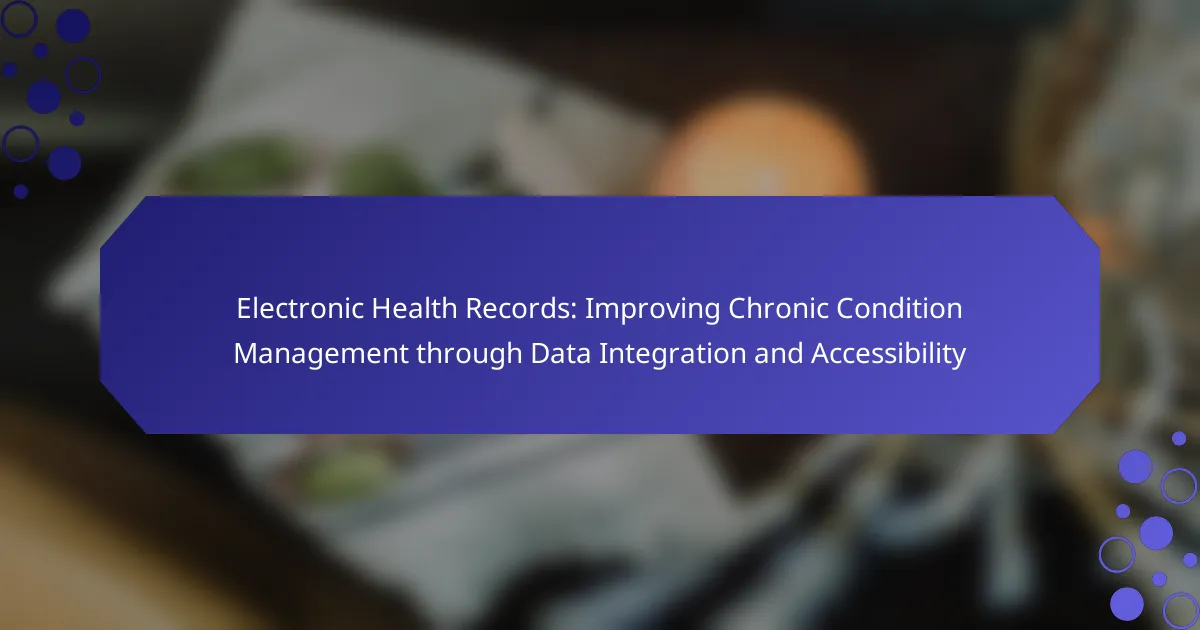Effective management of chronic conditions relies on integrated data access provided by Electronic Health Records (EHRs). This article explores how EHRs streamline patient information, enhance data integration from various sources, and address challenges like interoperability and user resistance. Additionally, it examines unique features that improve care coordination and patient engagement, ultimately leading to better health outcomes.

How do Electronic Health Records enhance chronic condition management?
Electronic Health Records enhance chronic condition management by providing integrated data access. They streamline patient information, enabling healthcare providers to monitor conditions effectively. This accessibility allows for timely interventions, improving patient outcomes. Additionally, EHRs facilitate communication between specialists, ensuring coordinated care. Enhanced data analytics can identify trends, leading to personalized treatment plans.
What are the key benefits of Electronic Health Records for patients?
Electronic Health Records enhance patient care by improving data accessibility, coordination, and chronic condition management. They provide a comprehensive view of a patient’s medical history, allowing for better-informed decisions.
Key benefits include:
1. Enhanced communication among healthcare providers.
2. Improved accuracy in diagnoses and treatment plans.
3. Increased patient engagement through accessible health information.
4. Streamlined prescription management, reducing errors.
5. Efficient monitoring of chronic conditions with real-time data updates.
These attributes significantly elevate the quality of care, making Electronic Health Records a vital tool in modern healthcare.
How do healthcare providers utilize Electronic Health Records for better outcomes?
Healthcare providers utilize Electronic Health Records (EHRs) to enhance patient outcomes through improved data integration and accessibility. EHRs facilitate real-time access to patient information, allowing for timely decision-making and personalized treatment plans.
By consolidating data from various sources, EHRs support coordinated care among multiple providers, which is crucial for managing chronic conditions. For instance, integrated data enables healthcare teams to monitor patient progress and adjust treatments accordingly, leading to better health management.
Additionally, EHRs can automate reminders for preventive care and follow-up appointments, ensuring patients receive necessary interventions promptly. This proactive approach significantly contributes to reducing hospital readmissions and improving overall patient satisfaction.
In summary, the effective use of EHRs in chronic condition management results in streamlined workflows, enhanced communication, and ultimately, better health outcomes for patients.

What role does data integration play in Electronic Health Records?
Data integration enhances Electronic Health Records by consolidating patient information from various sources, improving chronic condition management. This integration allows healthcare providers to access comprehensive data, leading to better decision-making and improved patient outcomes. For instance, integrated records can include lab results, medication history, and patient-reported outcomes, facilitating a holistic view of patient health. Increased accessibility of this data supports timely interventions, reducing complications and hospitalizations associated with chronic conditions.
Which systems are commonly integrated with Electronic Health Records?
Electronic Health Records commonly integrate with various systems to enhance patient care. Key systems include Practice Management Systems, Laboratory Information Systems, Radiology Information Systems, Pharmacy Management Systems, and Health Information Exchanges. These integrations improve data accessibility, streamline workflows, and facilitate better chronic condition management.
How does data sharing improve patient care in chronic conditions?
Data sharing significantly enhances patient care in chronic conditions by improving communication among healthcare providers. Integrated electronic health records facilitate real-time access to patient information, ensuring timely interventions. This approach reduces errors, enhances treatment adherence, and promotes personalized care plans. Studies show that effective data sharing can lead to a 30% reduction in hospital readmissions for chronic disease patients, illustrating its impact on overall health outcomes.

What challenges do healthcare organizations face with Electronic Health Records?
Healthcare organizations face significant challenges with Electronic Health Records (EHRs), including data interoperability, user resistance, and high implementation costs. Data interoperability issues hinder seamless information exchange between different systems, impacting care coordination. User resistance arises from the complexity of EHR interfaces and workflow disruptions. High implementation costs can strain budgets, especially for smaller practices, limiting their access to advanced EHR systems. These challenges can impede the effective management of chronic conditions, highlighting the need for improved integration and accessibility in EHR solutions.
Which common issues arise during implementation of Electronic Health Records?
Common issues during the implementation of Electronic Health Records include data entry errors, user resistance, and interoperability challenges. These problems can hinder effective chronic condition management.
Data entry errors often arise from inadequate training, leading to incorrect patient information. User resistance may stem from workflow disruptions or lack of perceived benefits, impacting adoption rates. Interoperability challenges occur when different EHR systems cannot communicate effectively, limiting data sharing and accessibility across healthcare providers.
Addressing these issues requires targeted training, stakeholder engagement, and robust system integration strategies.
How can healthcare organizations overcome resistance to Electronic Health Records?
Healthcare organizations can overcome resistance to Electronic Health Records by prioritizing user training and engagement. Effective strategies include demonstrating clear benefits, involving staff in the implementation process, and ensuring ongoing support.
1. Provide comprehensive training programs that focus on practical use cases.
2. Share success stories highlighting improved patient outcomes and efficiency.
3. Incorporate feedback mechanisms to address user concerns promptly.
4. Foster a culture of collaboration and open communication among staff.
5. Utilize change champions to advocate for EHR adoption within teams.
These approaches can enhance acceptance and facilitate smoother transitions to integrated health data systems.

What unique features differentiate Electronic Health Records across regions?
Electronic Health Records (EHRs) vary significantly across regions due to differences in regulatory frameworks, technology adoption, and data interoperability. These unique features impact chronic condition management and healthcare delivery.
EHRs in some regions prioritize patient privacy, while others emphasize data sharing for improved care coordination. For instance, the United States has stringent regulations like HIPAA, affecting data access and sharing. In contrast, European countries may focus on integrated health systems that enhance patient engagement.
Technology adoption also differs; some regions leverage advanced analytics and artificial intelligence for predictive insights, while others may still rely on basic digital records. Data interoperability remains a challenge globally, with regions like Scandinavia leading in seamless data exchange, enhancing chronic condition management.
Ultimately, these unique features shape the effectiveness of EHRs in improving healthcare outcomes and managing chronic conditions.
How do Electronic Health Records cater to diverse patient populations?
Electronic Health Records (EHRs) enhance care for diverse patient populations by improving data accessibility and integration. They facilitate personalized treatment plans that cater to specific cultural, linguistic, and health needs. EHRs enable healthcare providers to track health disparities, ensuring equitable care delivery. Additionally, they support interoperability, allowing seamless information exchange across different healthcare systems, which is crucial for managing chronic conditions effectively.
Which innovative technologies are enhancing Electronic Health Records functionality?
Innovative technologies enhancing Electronic Health Records (EHR) functionality include artificial intelligence, blockchain, cloud computing, and telehealth integration. These technologies improve data accessibility, enhance patient engagement, and streamline chronic condition management.
Artificial intelligence analyzes patient data for predictive insights, enabling proactive care. Blockchain secures patient information, enhancing data integrity and interoperability. Cloud computing provides scalable storage solutions, facilitating easy access to records. Telehealth integration allows remote consultations, improving access for chronic condition patients. These advancements collectively transform EHR systems, making them more efficient and user-friendly.

What are the rare attributes of Electronic Health Records that improve chronic care?
Rare attributes of Electronic Health Records that improve chronic care include interoperability, real-time data sharing, patient engagement tools, predictive analytics, and comprehensive data integration. These features enhance care coordination, streamline communication, and empower patients in managing their conditions effectively.
How do specific data analytics tools enhance chronic condition management?
Electronic Health Records (EHRs) enhance chronic condition management by providing integrated data access and improved patient information sharing. This integration allows healthcare providers to track patient histories, monitor treatment effectiveness, and adjust care plans based on real-time data. EHRs facilitate better communication among care teams, leading to more coordinated and efficient patient care. With features such as alerts for medication interactions and reminders for preventive care, EHRs support proactive management of chronic conditions.
What unique patient engagement features are present in some Electronic Health Records?
Some Electronic Health Records feature personalized patient portals, secure messaging, and remote monitoring tools. These unique patient engagement features enhance communication and empower patients in chronic condition management. Personalized portals allow patients to access their health data, while secure messaging facilitates direct communication with healthcare providers. Remote monitoring tools enable real-time tracking of health metrics, improving proactive care and patient involvement.

How can healthcare professionals optimize the use of Electronic Health Records?
Healthcare professionals can optimize Electronic Health Records (EHR) by enhancing data integration and accessibility. Streamlined data sharing among providers improves chronic condition management. Utilizing standardized formats ensures consistency, allowing for efficient patient information exchange. Training staff on EHR functionalities maximizes system use, leading to better patient outcomes. Regularly updating EHR systems with the latest technology enhances usability and security.
What best practices should be followed for effective Electronic Health Records management?
To effectively manage Electronic Health Records, prioritize data integration, accessibility, and user training. Establish standardized protocols for data entry and maintenance to enhance accuracy. Implement robust security measures to protect patient information. Regularly assess system performance and user feedback to identify areas for improvement.
Which common mistakes should be avoided when using Electronic Health Records?
To avoid common mistakes when using Electronic Health Records (EHRs), focus on data entry accuracy, user training, and system integration.
Firstly, ensure that data is entered correctly to prevent misinformation. Secondly, provide comprehensive training for all users to enhance system utilization. Lastly, prioritize the integration of EHR systems with other healthcare technologies to streamline workflows and improve patient care.
Neglecting these aspects can lead to inefficiencies and negatively impact chronic condition management.
